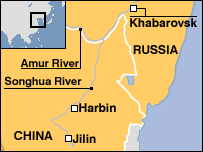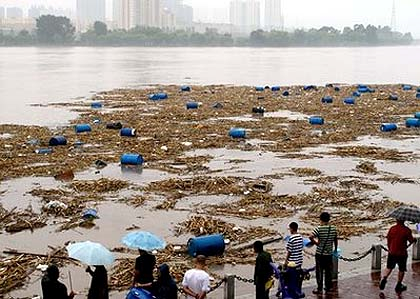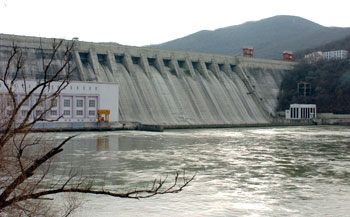Water Pollution Incident in the Songhua River
The Songhua River is a major river in northeast China. It runs through many cities in the region before joining the Amur River and then entering into Russia. The river has a catchment of 390,526 km². Average annual runoff is in the order of 1000 m³/s, and varies from less than 500 to more than 1,700 m³'/s between years. Low flows are observed between December to March, peak flows occur in August and September. Average flow during November is 627.3 m³/s with a standard deviation of 230. The river is the main water source of many cities and villages it passes by, including Harbin, the capital of Heilongjiang Province with a population of 3.5 million. Along the river is the old industrial base of China with many industries located on the river bank including the chemical industry.

On 13 November, 2005, an explosion took place at Jilin Chemical Industrial Co. plant (a PetroChina subsidiary) in Jilin, a city about 380 km up river from Harbin, caused by a worker's attempt to clear a blockage in the nitration tower of a chemical plant producing benzene. The powerful blasts caused harm to the environment and human safety. Five persons were confirmed dead and nearly 70 people were wounded. More than 10,000 residents were evacuated as a precaution against further explosions and severe pollution from the plant.

In this photo taken on Wednesday, July 28, 2010, people look at the chemical barrels floating on the Songhua River after they were washed away by the flood in Jilin city in northeast China's Jilin province. Floods caused by heavy rains in northeastern China stranded tens of thousands of residents without power Wednesday, as the worst flooding in more than a decade continued to besiege areas of the country. (AP Photo)
The explosion led to an outpouring of around 100 tons of chemicals (about 10 tanker-truck loads), including mainly benzene, spilled into the river Songhua. Benzene is a colourless, highly flammable liquid distilled from petroleum. It is used as a cleaning agent, solvent, in dyes and paints. Benzene is toxic, lethal to humans exposed to it in high levels. Chronic exposure leads to progressive degeneration of bone marrow and leukaemia.
On 21 November 2005, the Municipal Government of Harbin had to temporarily shut down its water supply, leaving around 3.5 million people temporarily without access to tap water but bottled water provided by the government. On 22 November, state media said water could have been contaminated after the blast. On 23 November, around 10 days after the explosion, the authorities admitted very high levels of benzene had been found in the water, an 80-km contaminated stretch of water reached Harbin and took 40 hours to pass through it. after the 13th November explosion at the plant upstream. The incident caused a serious water crisis domestically and internationally in the region along the river. The toxic plume is expected to reach the city of Khabarovsk with a population of 1,500,00 in a few days. Khabarovsk is situated downstream of the confluence of the Songhua river and the Amur, which should further dilute the toxic load.
The water from the Songhua River used by the city's water supply was purified with active carbon after the polluted water has passed Harbin. The purification project is carried out by the Peoples' Liberation Army of China.
Another mitigations measure was to increase the river flow. The photo taken on November 23, 2005 shown the dam of the Fengman Reservoir on the Songhuajiang River in Jilin, a city in northeast China's Jilin Province. The reservoir release had increased the river flow to 600 cubic meters per second, about four times more than the usual, since November 15 to help dilute the pollution and speed up the passage of the contaminant plume.

[頁首 Top]
|